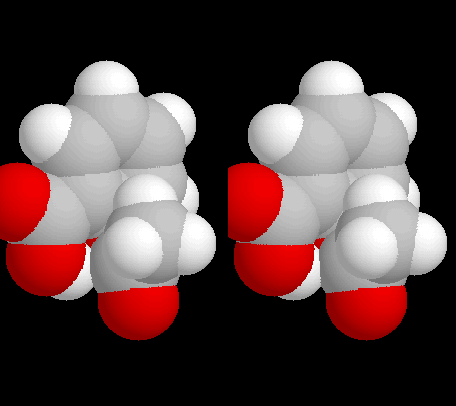Note: both the carboxyl group and the acetyl group have a keto oxygen! This is important when you look at the 3D structure below.
Aspirin is arguably the most important drug in medical science.
Although it does not cure major diseases it is the most common over-the-counter
drug sodk, and is highly effective for relief of minor aches and pains.
The scientific name for aspirin is Acetyl salicylic
Acid.
| Acetyl salicylic Acid (2-acetoxy benzoic
acid) is the acetylated form of Salicylic Acid . In the diagram
to the left, Salicylic Acid (2-hydroxy
benzoic acid) is shown in black. It consists of a benzene ring and
a carboxylic acid group. The acetyl group is shown in red.
Note: both the carboxyl group and the acetyl group have a keto oxygen! This is important when you look at the 3D structure below. |
The 3D structure of Aspirin is shown in the two figures below. On the left is a stereo picture showing a space-filling model of Aspirin. The oxygens are in red, the carbons are in grey and the hydrogens are in white. The top oxygen on the left is the keto oxygen of the carboxylic acid. The bottom oxygen on the left is the oxygen in the hydroxyl group of the carboxyl. The oxygen to the bottom right is the keto oxygen of the acetyl group. To make this clear, look at the wire frame diagram on the right. It shows the aspirin molecule from the same perspective as the stereo picture, and the individual chemical moieties are labeled (only the bonds - not the atoms, are shown).
To view the stereo structure, unfocus your eyes, and stare at the picture from a distance of approximately 2 feet. Concentrate on the "third" image in the middle until it focuses in 3D. It may help to look at the methyl group - it should appear to be "in front" of the benzene ring. It may help to slowly move your head up and down, or to move in and out.
NOTE: The stereo view of Aspirin shows that this
chemical has a 3-Dimensional SHAPE!
 |
WHAT YOU SHOULD KNOW:
Something of Interest: The History of Aspirin
Aspirin is a trade name for acetylsalicylic acid, a common analgesic (pain reliever). The earliest known uses of the drug can be traced back to the Greek physician Hippocrates in the fifth century B.C. He used powder extracted from the bark of willows (the genus name is Salix, hence the name Salicin) to treat pain and reduce fever.
Salicin, the parent of the salicylate drug family, was successfully isolated in 1829 from willow bark. Sodium salicylate, a predecessor to aspirin, was developed along with salicylic acid (see below) in 1875 as a pain reliever.
Sodium salicylate was not often popular though, as it has a habit of irritating the stomach. However, in 1897, a man named Felix Hoffman changed the face of medicine forever. Hoffman was a German chemist working for Bayer. He had been using the common pain reliever of the time, sodium salicylate, to treat his father's arthritis. The sodium salicylate caused his father the same stomach trouble it caused other people, so Felix decided to try and concoct a less acidic formula. His work led to the synthesization of acetylsalicylic acid, or ASA. This soon became the pain killer of choice for physicians around the globe and is still marketed under the name of Bayer Aspirin.
The synthesis is a classical acetylation
with Acetic Anhydride. It is very simple and is sometimes done
in undergraduate Organic Chemistry labs starting with Salicylic Acid
(2 hydroxy benzoic acid) :

This figure was downloaded from: http://wwwchem.csustan.edu/chem1002/aspirin.htm
Scientists never really understood the inner workings of the drug however. It wasn't until the 1970's, when British pharmacologist John Vane, Ph.D. began work on aspirin that people began to understand how aspirin really works. Vane and his colleagues found that aspirin inhibited the production of hormone like substances called prostaglandins. While the exact mechanism is not completely clear, the assumption is that aspirin does this by blocking an enzyme which catalyzes a step in the biosynthetic pathway to the prostaglancdins.
The prostaglandins regulate certain body functions, such as blood vessel elasticity and changing the functions of blood platelets. Thus can aspirin affect blood clotting and ease inflammation.
This history of aspirin was found at: http://www.erols.com/blopatin/reference/aspirin/history.html
Follow this link for
a more complete discussion of Aspirin and its
history.
Back to "BioOrganic Molecules".